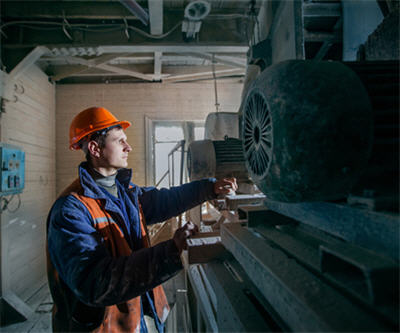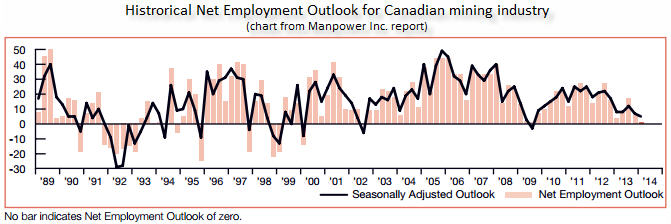Back to miners graduating with 6-figure salaries ‘in a few years’

The Canadian Mining Associations’ latest Facts & Figures report reveals the industry employed more than 418,000 people in full-time-equivalent positions.
Mining-related employment represent one in every 41 Canadian jobs and accounted for 20% of the value of the North American country’s exports.
In 2012 the average weekly pay for a mining worker in 2012 was $1,559 – surpassing the earnings of workers in forestry, manufacturing, finance and construction, but last year the outlook for the industry darkened considerably.
Canadian mining companies are becoming increasingly unwilling to add employees to their payrolls and are reporting the weakest hiring intentions since the third quarter of 2009, according to a recent employment outlook survey by labour consultants Manpower.
Of the Canadian mining companies surveyed, 14% said they plan on hiring over the first quarter of this year and 13% plan on downsizing. Adjusted for seasonal variation, this puts Canada’s mining Net Employment Outlook at 5% – a 2% drop on the previous quarter, and a 3% drop on Q1 2013.
Data from Statistics Canada also show jobs for miners are becoming scarcer.
The government agency’s latest unemployment-to-job-vacancies ratio for the mining and energy sector is 3.5, compared to a 1.1 ratio – meaning applicants were virtually assured of a position – around five years ago when the resources sector was booming.
Macleans reports looking a bit further into the future the outlook for mining jobs in the country is still rosy.
The magazine quotes Scott Dunbar, the interim head of the University of British Columbia’s mining engineering department, as saying the soft job conditions in the sector is a short-term problem that will correct itself “in a few years, at most.”
A huge factor that will positively affect the market is the fact that at the moment the majority of jobs in the industry are still occupied by baby boomers, a demographic now entering retirement:
“Ryan Montpellier, the executive director of the Mining Industry Human Resources Council—which foresaw the commodities slump—says the industry will still need at least 145,000 workers over the next 10 years, just to replace outgoing workers.
“On top of that, roughly $140 billion worth of new projects is currently awaiting government approval, including developments in northern Ontario’s Ring of Fire mineral belt. “If even a small fraction of those new mines comes on board, it will mean a significant increase in the number of people.
“If you start overlaying employment growth on top of replacement, we’re going to go right back to the very challenging years in 2007 and 2008, when there was a significant skill shortage and when you had mining engineers graduating with six-figure salaries.”
While the job climate for Canadian miners at the moment is even worse than in the US, in Australia the sector’s net employment outlook stands at just 1%, even though that represents a moderate gain on the prior quarter.

Homepage image of workers in control of Andina mine operations courtesy of Codelco
More News
{{ commodity.name }}
{{ post.title }}
{{ post.date }}


2 Comments
Andrew Woburn
I have no mining experience but I know “Human Resource” departments exist to keep unworthy people out. This is not new. I wanted a certain Canadian federal government job in the 1970’s. HR told me there were no jobs open and wouldn’t be for at least six months. I knew I had desirable qualifications so I wrote to the regional boss of that department and was hired in a week. The bigger the organization, the less HR actually knows about its needs. Forget them, talk to the guy that needs you.
adanac
That is an out and out blatant lie. Jason Kenny has been bringing foreigners over here, that are not even ticketed nor certified.
Once Communist China takes Canada over on Oct 1st? We know there will be Chinese brought over in the thousands of thousands. They are going to absolutely overrun BC especially. Canadians have to be ticketed, certified and have degrees right up to ying yang. And, still are not getting the resource jobs.